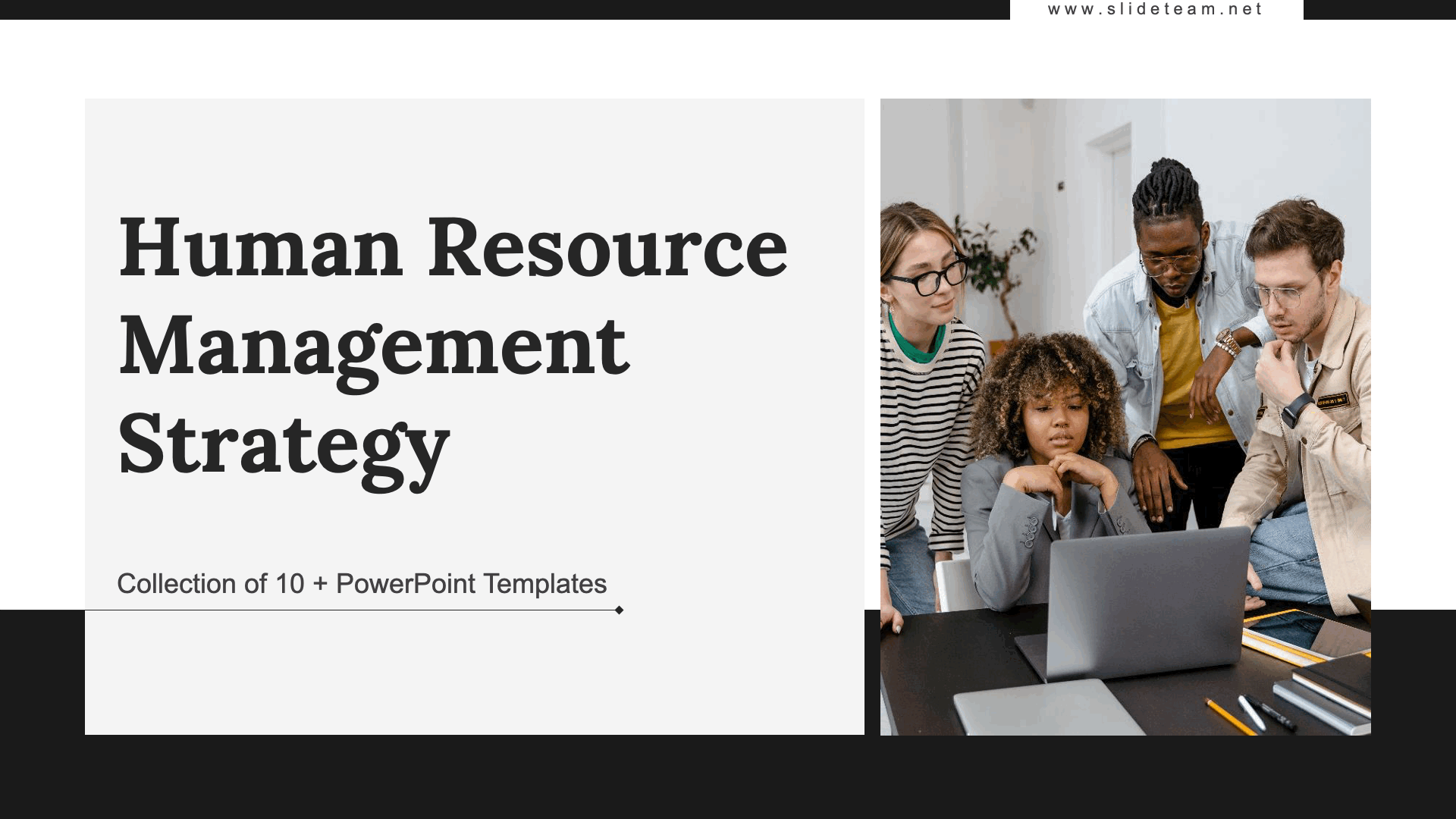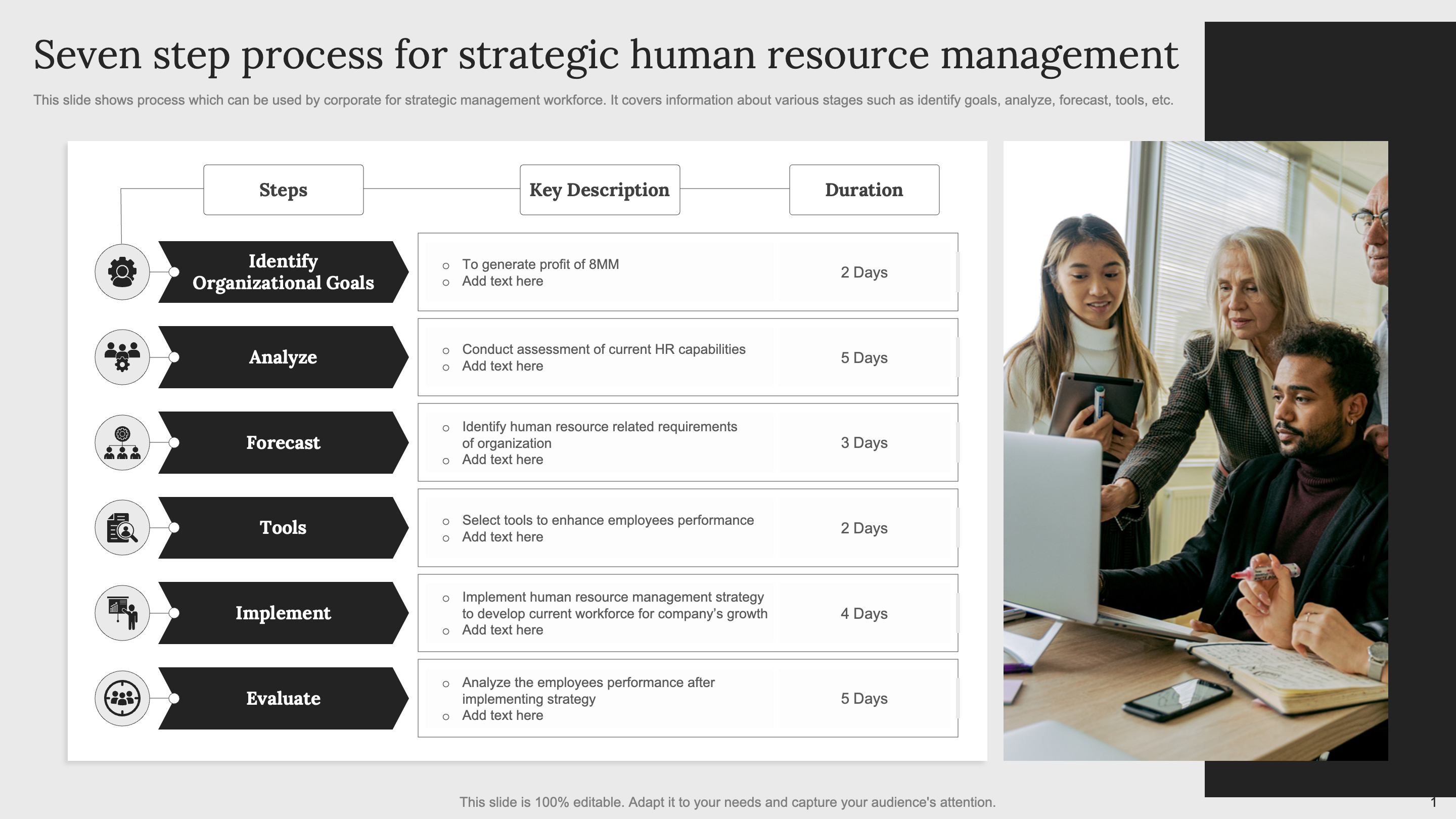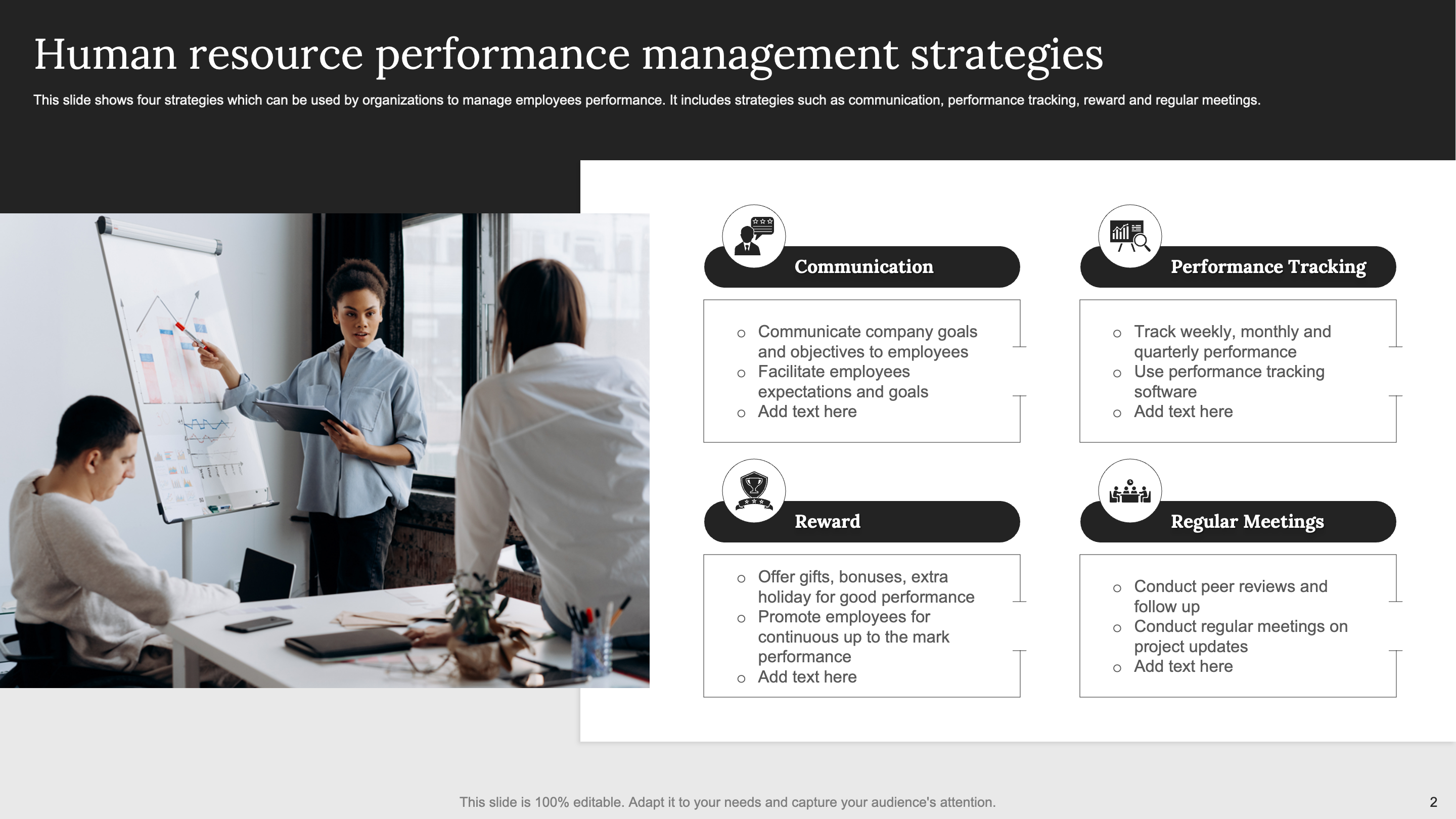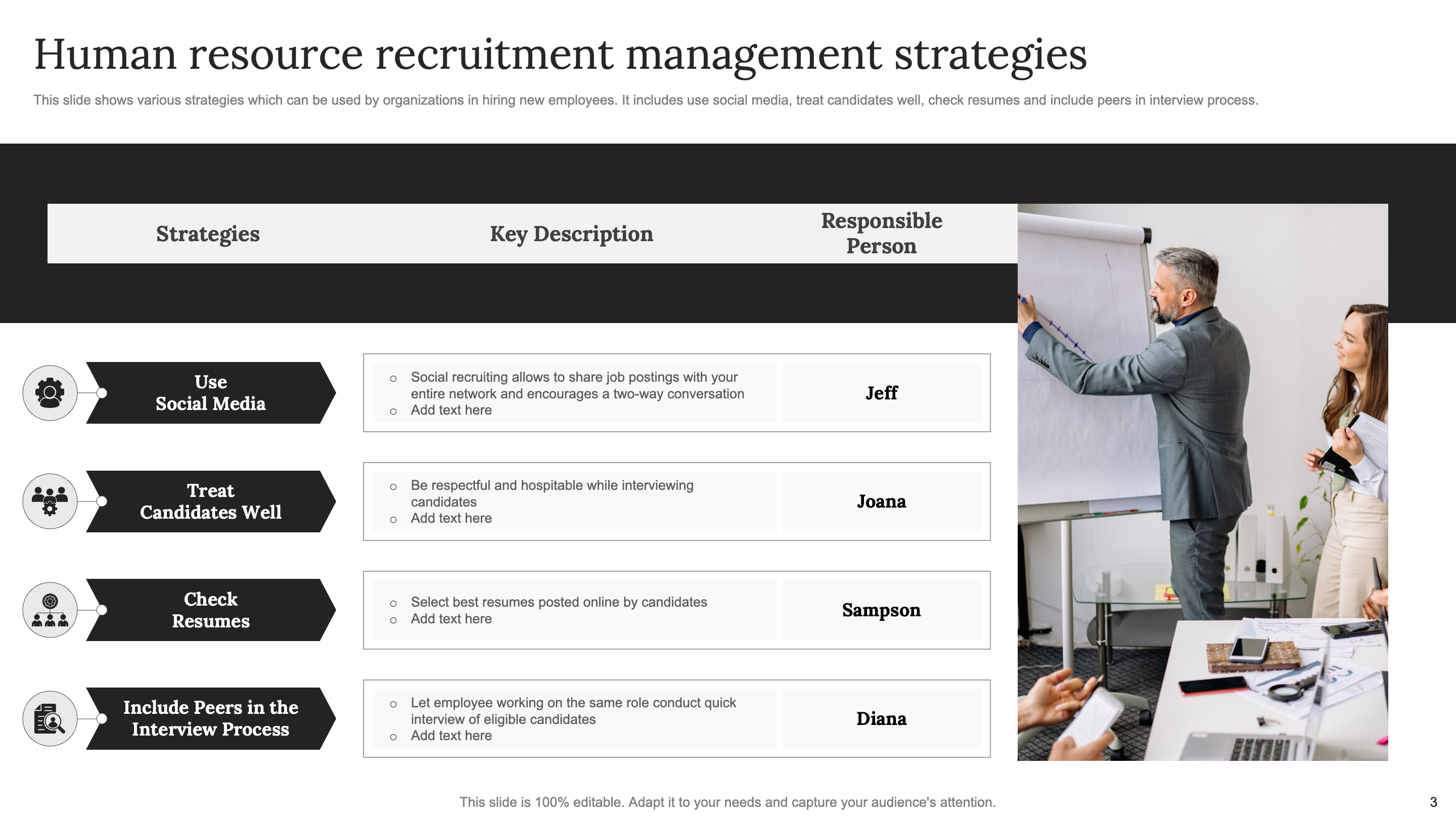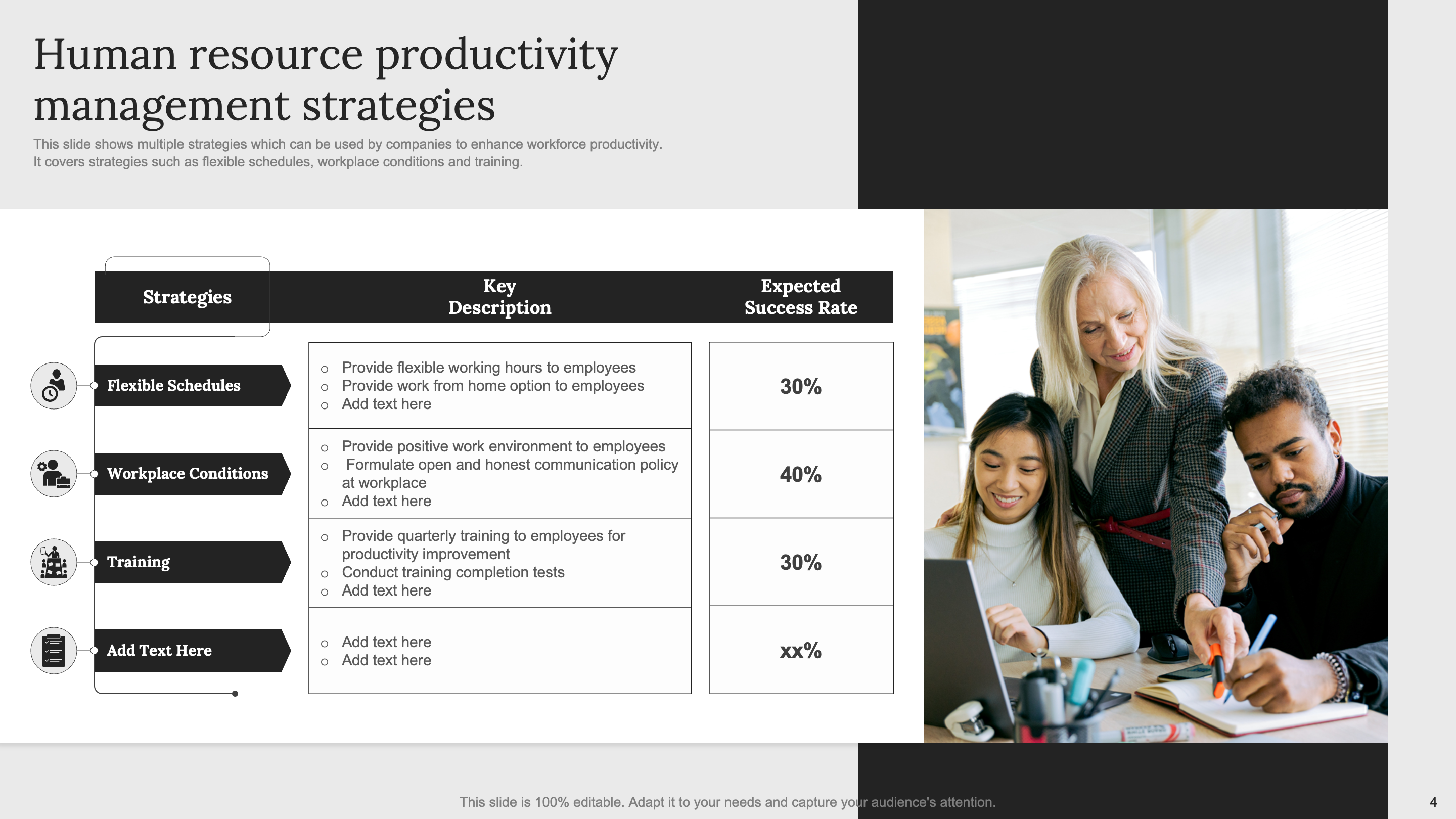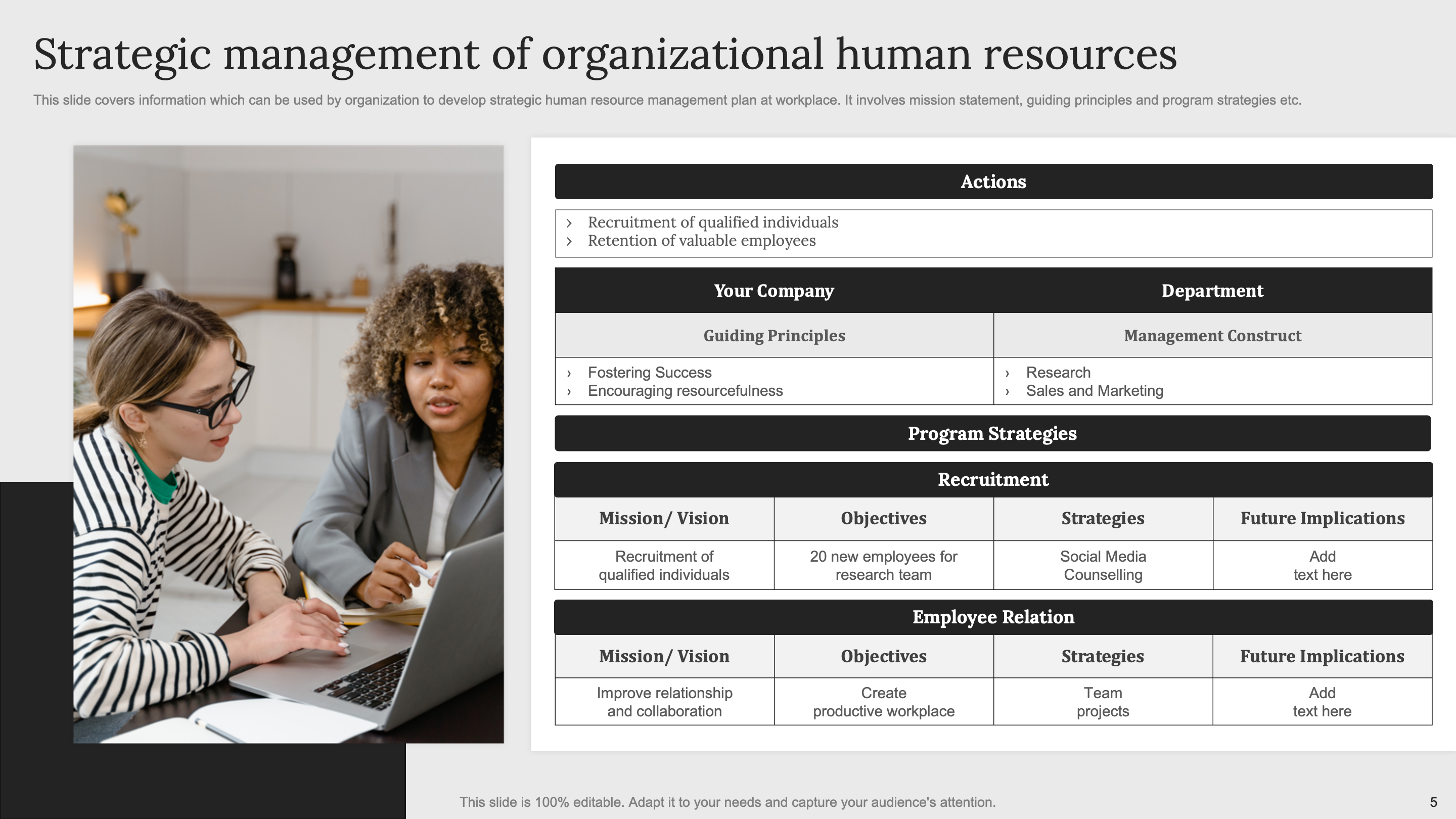The management of personnel in an organization is achieved through the implementation of a Human Resource Management Strategy (HRMS). This methodology aligns human resources with corporate objectives, acting as a bridge to connect both elements. With HRMS, firms can strengthen employee performance and development initiatives while crafting programs that support company strategies. This approach enables businesses to achieve their goals more efficiently by optimizing resource utilization towards desired ends.
Understanding Human Resource Management Strategy
Human Resource Management Strategy (HRMS) contains a futuristic outlook that surpasses the typical HR functions. It includes combining HR tactics with the strategic objectives of an organization to boost human capital into a crucial component for achieving success. In short, HRMS is forward-thinking and encourages superior business performance through proactive people management practices and growth strategies.
PowerPoint Slides to Develop an Effective Human Resource Strategy
Let’s dive into a step-by-step process of creating an effective human resource management strategy with the help of PowerPoint templates.
Seven Step Process for Strategic Human Resource Management
The slide outlines a seven-step process for strategic human resource management:
- Identify organizational goals: This phase includes establishing the company's comprehensive aspirations and HR's potential contribution. For example, the goal can be to attain a profit worth $8 million.
- Analyze: In this stage, you assess the present abilities of HR and detect any deficiencies or potential spots for enhancement.
- Forecast: Using your analysis, make a projection of the HR requirements that may arise in the future for the organization.
- Tools: Select appropriate HR tools and technologies to enhance employee performance, as well as strengthen your HR strategy.
- Implement: Take action on your HR strategy by creating and executing HR initiatives.
- Evaluate: Analyze employee performance data to monitor and assess the efficiency of your HR strategy.
- Refine: After assessing your HR approach, adjust it accordingly to make sure it supports and aligns with the objectives of your organization.
This is merely a fundamental outline of the seven-step procedure. Nonetheless, this template is entirely customizable, and you have the full freedom to modify any aspect to suit your company's particular requirements.
Download this PowerPoint Template Now!
Human Resource Performance Management Strategies
The slide displays effective approaches to managing human resources performance. It contains four methods that companies can utilize for improving employee productivity, including communication, monitoring of performance, incentivization, and scheduled meetings.
- Communication: It involves sharing the goals and objectives of a company with its employees while also enabling conversations about their own expectations and aspirations.
- Performance tracking: To track employee performance, organizations may opt for weekly, monthly, and quarterly evaluations. One way to assist in this process is by using specialized software designed for performance tracking.
- Rewards: Entities have the option of providing incentives, such as presents, supplements, or additional vacation days for exceptional work. They may likewise elevate staff members who continuously fulfill or exceed anticipated outcomes.
- Regular meetings: Entities have the option to hold recurrent gatherings in order to talk about progress on projects and contribute analysis to staff members.
These four strategies can enhance employee performance and help organizations attain their business objectives.
Download this PowerPoint Template Now!
Human Resource Recruitment Management Strategies
The slide showcases four strategies that organizations can use to hire new employees. These strategies are:
- Use social media: Social media can be utilized by organizations to connect with potential candidates and promote job opportunities via platforms such as LinkedIn.
- Treat candidates well: Ensuring good treatment of candidates entails displaying respect and hospitality towards them throughout the entire interview process.
- Check resumes: Organizations should thoroughly examine all candidate resumes to ensure that they have the appropriate qualifications for the job.
- Include peers in the interview process: By involving peers in the interview process, you can verify whether a forthcoming employee aligns well with your company culture.
With these four strategies, organizations can increase the likelihood of hiring qualified and talented employees.
Download this PowerPoint Template Now!
Human Resource Productivity Management Strategies
This slide shows how companies can increase workforce productivity through flexible schedules, improving workplace conditions, and investing in training.
- Flexible schedules: Offering adaptable schedules, such as flexible work hours can enhance employee satisfaction by encouraging them to handle their personal commitments. This practice is recommended for improving staff morale.
- Workplace conditions: To promote a favorable work setting establish an atmosphere of candid and transparent communication. To achieve this objective, consider scheduling frequent employee evaluations and cultivating a feedback-oriented atmosphere.
- Training: Regular training can prepare employees with the necessary skills and knowledge to enhance productivity. To achieve this, conduct quarterly training sessions coupled with performance assessments aimed at measuring how practical each session is.
With the adoption of these tactics, organizations can establish a workplace atmosphere that encourages efficiency and empowers staff to achieve optimal performance.
Download this PowerPoint Template Now!
Strategic Management of Organizational Human Resources
Craft a successful strategic HR plan by following this roadmap. Defining your core identity through a mission statement is the starting point, followed by identifying guiding principles that will shape your HR practices (for example, promoting resourcefulness).
Then, get into specific strategies and programs such as recruitment tactics utilizing social media platforms or counseling services for employees in need of support. Employee relations should also be highlighted with efforts to create productive environments while encouraging team projects. Finally, use data-driven approaches through research on recruitment effectiveness and employee happiness/retention rates to continuously refine your strategy.
Following these steps empowers you to design an effective HR plan that aligns with company goals.
Download this PowerPoint Template Now!
Conclusion
The strategic administration of human resources is a diverse field that carries significant weight in guaranteeing an organization’s success. Strategic HRM involves predicting future opportunities and formulating strategies that correspond with the company's objectives while remaining flexible to any alterations within the firm.
To uphold a dedicated, professional, and driven workforce, corporations must allocate resources toward HR methods that draw in talent and nurture staff retention. This requires effective management throughout the employee lifecycle while foreseeing business and personnel requirements with adaptability in consideration.
If you are eager to explore more HRM strategies and obtain valuable perspectives from professionals in the field, we encourage you to access our complete presentation on HRMS. This PPT offers an in detail process of creating and executing effective HR strategies that correspond with your business goals while improving organizational productivity.



Frequently Asked Questions
Q: What is the significance of a Human Resource Management Strategy (HRMS) in an organization?
HRMS plays a crucial role in aligning human resources with corporate objectives, acting as a bridge between HR functions and organizational goals. It goes beyond traditional HR practices, fostering proactive people management and growth strategies to enhance overall business performance.
Q: How can organizations create an effective HR strategy?
Organizations can follow a seven-step process, including identifying organizational goals, analyzing current HR capabilities, forecasting future HR requirements, selecting appropriate tools, implementing initiatives, evaluating performance, and refining the strategy based on assessment results. PowerPoint templates are available to guide through this process.
Q: What are the key strategies for managing human resource performance?
Effective human resource performance management involves communication, performance tracking, rewards, and regular meetings. These strategies help improve employee productivity by fostering clear communication, monitoring performance, providing incentives, and facilitating consistent engagement through meetings.
Q: What recruitment strategies can organizations employ to attract qualified candidates?
Organizations can use social media platforms like LinkedIn to connect with potential candidates, ensure respectful treatment throughout the interview process, thoroughly check resumes for qualifications, and include peers in the interview process to assess cultural fit. These strategies enhance the likelihood of hiring talented and qualified employees.
Q: How can companies increase workforce productivity through HR strategies?
Companies can enhance workforce productivity by implementing flexible schedules, improving workplace conditions through transparent communication and frequent evaluations, and investing in regular training sessions. These tactics contribute to employee satisfaction, create a positive work environment, and empower staff with the skills needed to achieve optimal performance.


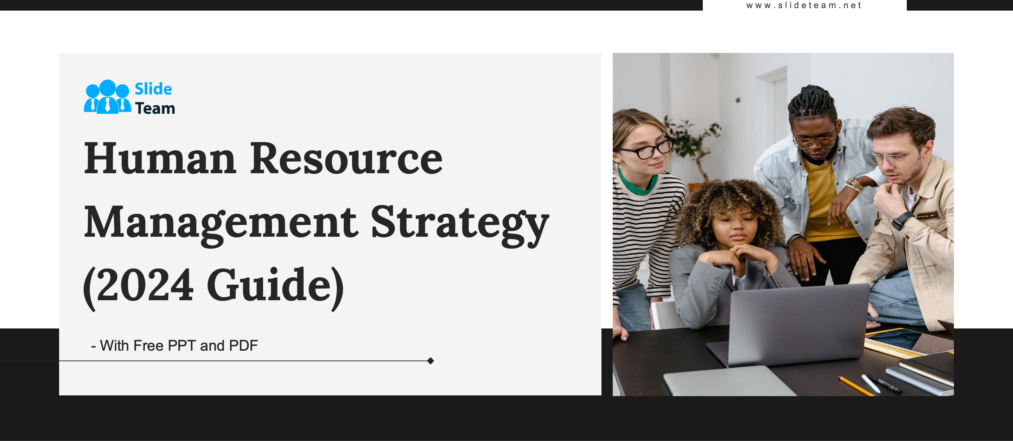


 Customer Reviews
Customer Reviews

